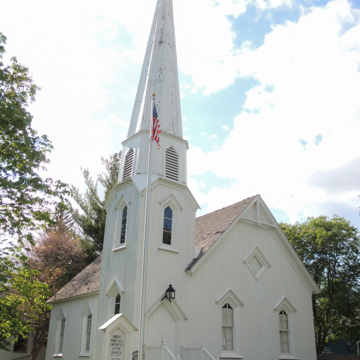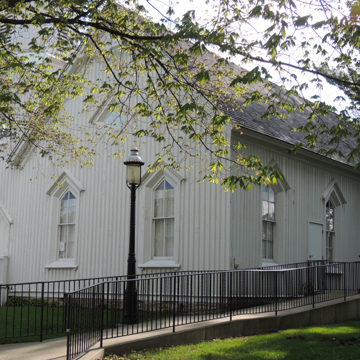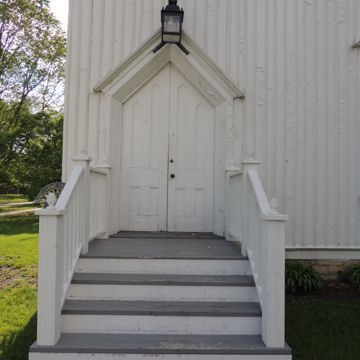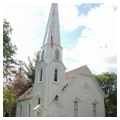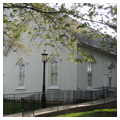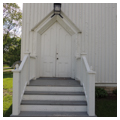Like so many Illinois towns, Dwight’s fortunes were initially tied to the arrival of the railroad in 1854. Richard P. Morgan, an early settler and land speculator, donated the site of the town’s first church. Built in 1857 for a Presbyterian congregation, the Pioneer Gothic Church is a fine example of Carpenter Gothic. Once relatively common throughout Illinois, only a handful of Carpenter Gothic churches remain intact in the twenty-first century.
The Pioneer Gothic Church has survived four major fires that have swept away most of Dwight’s other early buildings. This diminutive structure (27 x 54 feet) stands at a corner leading from the central business district into a residential neighborhood. It has board-and-batten siding made of pine and tulip wood. All of the windows are lancet-arched with heavy, pointed cornices and clear glass, double-hung sashes. A corner bell tower houses the entrance vestibule. The tower has clipped corners on the roof at each level and lancet-shaped windows, which greatly add to the effect of the church’s Gothic character.
Two lancet windows on the front have a diamond-shaped window centered above them in the gable. Carpenter Gothic stickwork decorates the gable end. At the rear is a tripartite Gothic window with colored glass that lights the chancel inside.
The Pioneer Gothic Church survived intact despite a century of extraordinary growth in and around Dwight. In 1870, the Keeley Institute was founded in the town, the first program in the United States to treat alcoholism as a medical problem. At the height of the Institute’s reputation, over 800 people a week stepped off the train at the Dwight depot for treatment and the town was profoundly influenced by the Keeley’s growth. Dwight had paved streets, electricity, and public water and sewer systems long before most other rural communities. When, in the 1920s, Route 66 bypassed Dwight’s downtown, the town met the challenge by building new businesses closer to the highway. Although the Keeley Institute has been gone since 1996 and Route 66 is now a tourist attraction rather than a major highway, Dwight remains a bustling small town with a railroad running through its center.
Despite the church’s presence in a residential neighborhood and its small size, the congregation and the town never seem to have considered it expendable. When it ceased functioning as a church, the building served as the township hall. It was restored in 1965 and today houses the local historical society.
References
Thorsen, Anthony J., and Michael Ward, “Pioneer Gothic Church,” Livingston County, Illinois. National Register Inventory–Nomination Form, 1983. National Park Service, U.S. Department of the Interior, Washington, D.C.

